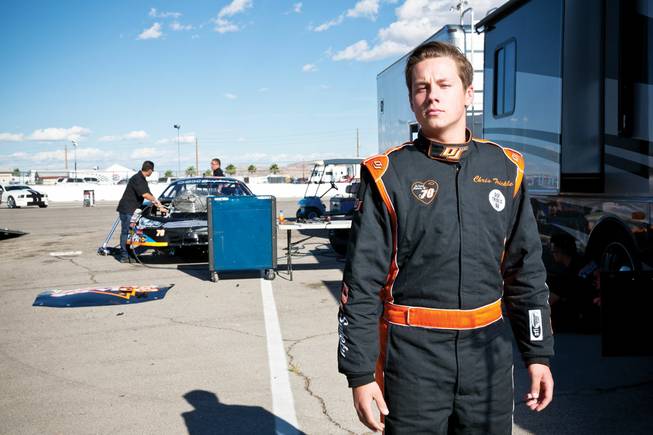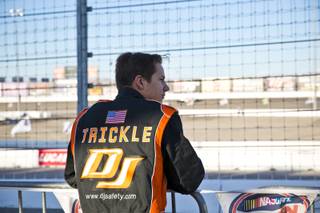
Chris Trickle, 14, or Little Chris as he is known to family, needed only three races to earn his first victory in the NASCAR Whelen All-American Series’ Super Late Models division in 2014.
Sunday, May 31, 2015 | 2 a.m.
Chris Trickle already acts like a NASCAR driver, signing autographs and chatting with fans at the track.
Racing in Las Vegas
Big-time racing in Southern Nevada didn’t begin in 1996 with the opening of the 1.5-mile asphalt track at the Las Vegas Motor Speedway. The nation’s top racing series have been coming to Las Vegas — and attracting big names — since the 1950s. Here’s a look at the area’s racing venues, past and present:
Las Vegas Park Speedway
The 1-mile dirt track opened in 1953 as a horse-racing facility, and three major races were staged there from 1954 to 1959: a race in NASCAR’s top series, known then as the Grand National division; a Champ Car race; and a United States Auto Club Stock Car race. The land now is the site of the Westgate resort, the Las Vegas Convention Center and part of the Las Vegas Country Club.
Craig Road Speedway
The quarter-mile paved oval on the southeast corner of Craig Road and Fifth Street was open from 1965 to 1982 and hosted K&N series races from 1970 to 1979. Roger Mears, Mark Martin, Ray Elder and Rodger Ward raced there.
Stardust International Raceway
The Stardust resort built the 13-turn, 3-mile road course and a quarter-mile drag strip in 1965 to attract high rollers. In a 1968 USAC Champ Car race, Bobby Unser outdueled Mario Andretti for the win; Al Unser and A.J. Foyt were unable to finish. In the early 1970s, the land was sold to developers and became the site of the Spring Valley community.
Caesars Palace
The 14-turn, 2.268-mile road course in the parking lot north of the hotel was the site of Formula One races in 1981 and 1982. The track was reconfigured into a flat, 1.125-mile distorted oval and hosted CART and NASCAR K&N Pro Series West races in 1983 and 1984. Indianapolis 500 winners Tom Sneva and Andretti won races at the track.
Las Vegas Motor Speedway
The complex off Las Vegas Boulevard near Nellis Air Force Base includes the tri-oval superspeedway, the 3/8-mile Bullring oval, a half-mile clay dirt track and a quarter-mile asphalt dragstrip. NASCAR’s three top series, as well as other stock-car and open-wheel series, have raced at the superspeedway. Race winners include series champions Jeff Gordon, Jimmie Johnson, Tony Stewart, Kevin Harvick and Brad Keselowski; and Las Vegas natives Kyle Busch and Brendan Gaughan.
Las Vegas Street Circuit
Will Power won a CART race through the streets of downtown Las Vegas in 2007. The Vegas Grand Prix was canceled after the dissolution of the Champ Car World Series in 2008.
Drag racing
From street races on Vegas Valley Drive in the 1950s to the Las Vegas Motor Speedway dragstrip today, drag racing has been a staple of Las Vegas’ auto culture. The valley’s first true dragstrip was Thunderbird Raceway, which opened in 1958 on the site of a former World War II auxiliary runway in Henderson. Later, drag races were contested at the Stardust International Raceway before the the Las Vegas Speedrome was built in the 1970s on the current Las Vegas Motor Speedway site.
He makes sure to thank his sponsors like a pro, too, rattling off their names before a recent race at the Las Vegas Motor Speedway.
It’s easy to forget Chris is only 14 — especially when he’s winning races, which he has done at the Bullring since he was 8.
Now, he’s beating even the grown-ups. Chris, known to his family as Little Chris, made the leap to the NASCAR Whelen All-American Series’ Super Late Models division in 2014 and needed only three races to earn his first victory.
“That night, I knew what I wanted to do for the rest of my life,” he said.
The family name should be familiar to racing fans. Chris’ uncle was Midwest short-track legend Dick Trickle, who is thought to have won more than 1,200 feature races and was the 1989 rookie of the year in NASCAR’s top series — at age 48.
Chris’ adoptive father and Dick Trickle’s brother, Chuck Trickle, had a son, also named Chris, who was a star in Southwest racing. He was moving up to NASCAR’s truck series when he was shot in 1997 while driving on Blue Diamond Road near the Silverton. He died a year later at age 24; the shooter never was found.
Today, Little Chris drives the No. 70 Star Nursery car, just like Big Chris did years ago.
Some of the drivers Little Chris competes against in the Whelen All-American Series are in their 50s. The series has a minimum age of 14. Chris said the other drivers don’t treat him differently.
“When I came out here, I was like, ‘OK, I’m a rookie. They’re probably going to rough me up,’” he said. “But no, actually, I drove clean with them and they drove clean with me. They respect me, and I respect them.”
Chris worked his way up by racing go-karts, bandolero cars, legend cars and quarter midgets. He won about 100 of his first 400 races, Chuck estimates.
Chris said he was scared when he first got into a go-kart at age 5, but it didn’t take him long to change his mind.
“After I had my first race, that’s all I wanted to do,” he said. “I just wanted to stay in the car. When my dad pulled me off the track, I stayed in the car.”
Chris also learned plenty about racing from Dick Trickle, who died in 2013.
“What did Uncle Dick tell you?” Chuck asked.
“Keep my nose clean,” Chris said.
But Chris said his father, who also has raced, is his mentor because he constantly teaches him new things about racing.
“My first race, I used all my brakes, so I had to slow down getting in (the corners) and getting off,” Chris said, meaning he was wearing down the car’s brake pads and had to learn to slow down and speed up using the accelerator pedal. “I didn’t know that until he taught me.”
Chris enjoys watching NASCAR races but doesn’t try to learn from them. He learns by watching videos of himself on the track.
“I don’t watch all my races,” he said. “I just watch when I won because that’s when I was quick. That’s the line I need to run.”
Although he’s focusing on driving his super late model, which has a two-speed transmission and about 450 to 500 horsepower, Chris is eyeing the national ARCA Racing Series or the regional K&N Pro Series West as his next stop. After that, he hopes to race in NASCAR’s Camping World Truck Series, which has a minimum age of 16.
He doesn’t hesitate when asked where he thinks he’ll be in five years: “I see myself at the top of NASCAR. The very top. … I dream about it. I want to live it.”
Chuck Trickle knows it will take time before his son runs with the big boys of stock car racing’s elite level.
“Right now, we’re crawling,” he said. “It’s a good start. Now, we gotta walk.”
Chris adds: “Then, we gotta run.”
Follow Chris Trickle on Facebook at Facebook.com/ChrisTrickle70 and Facebook.com/ChrisTrickleRacing or on Twitter at Twitter.com/ChrisTrickle70. Also, see his photos and videos on Instagram at christrickle_.


Join the Discussion:
Check this out for a full explanation of our conversion to the LiveFyre commenting system and instructions on how to sign up for an account.
Full comments policy